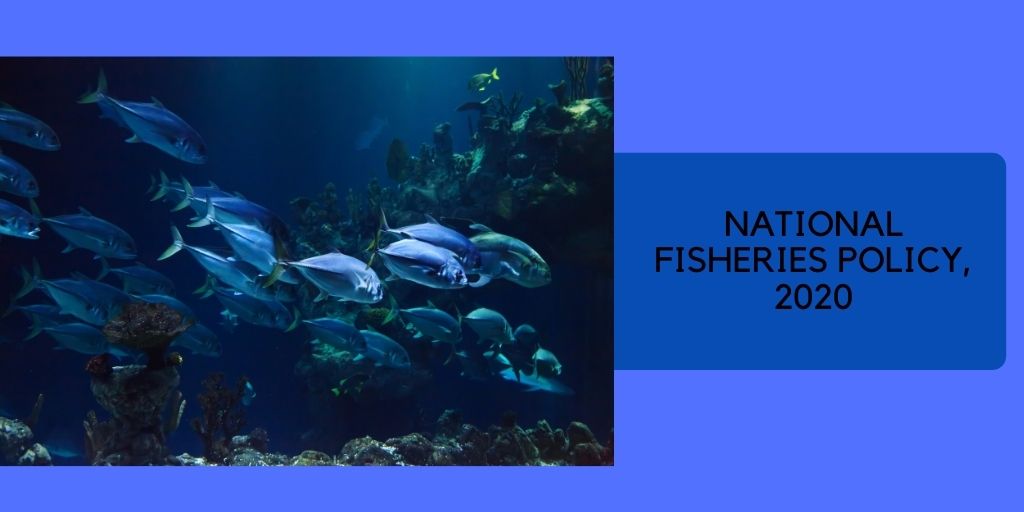The National Fisheries Policy 2020 would offer a strategized way forward to develop, harness, manage and regulate capture and culture fisheries in a responsible and sustainable manner. The Policy will ensure a productive integration with other economic sectors, such as agriculture,coastal area development and eco-tourism, to meet the goals of the ‘Blue Economy’.Whilecenter-state and interstate cooperation, socio-economic up-liftmen and economic prosperity of fishers and fish farmers’
BACKGROUND
Fisheries are an important source of food, nutrition, employment and income in India.
The sector provides livelihoods to about 16 million fishers and fish farmers at the primary level and almost twice the number along the value chain.
The sector has immense potential to more than double the fishers and fish farmers’ incomes, as envisioned by the government.
Commencing as a purely traditional activity, fisheries have now transformed in to a commercial enterprise.
The share of fisheries sector in the total GDP (at current prices) increased from 0.40% in 1950-51 to 1.03% in 2017-18.
OBJECTIVES .
The policy aims at comprehensive development of the fisheries sector through appropriate interventions to address the critical gaps with an overarching goal for growths in exports, increase in farmer’s income and better choice for consumers.
The various objectives of the policy are to:Optimally harness the capture and culture fisheries potential of the country by enhancing fish production and productivity in a responsible and sustainable manner.
A robust management and regulatory framework with necessary legal backing for effective fisheries resource management through an Ecosystem Approach of Fisheries (EAF) management
MARINE SECTOR
Fisheries Management
(i) Fisheries governance will be improved to facilitate coordination among States/UTs, National Agencies and other stakeholders. The comprehensive Management and regulation of fisheries resources in the EEZ will be ensured with a national law
Island Fisheries
Keeping in view the fact that more than 30% India’s EEZ lies around the Island territories, Government will implement dedicated programmesfor developing fisheries sector in islands. Such plans will inter alia include framework for sustainable fisheries exploitation, Island tourism, availability of floating refueling barges, mother carrier vessels and mobile fisheries ambulances
MARICULTURE
Maricultureis the cultivation of economically important marine plants and animals in the sea having tidal influence and includes onshore facilities like brood banks, hatcheries, nursery rearing and grow-out systems using seawater. (i) An enabling environment for sustainable development of mariculture in India
INLAND FISHERIES
RiverineFisheries
The restoration of natural productivity and conservation of indigenous fisheries resources through ecosystem restoration would be the primary focus of riverine fisheries. States/UTs will put in place appropriate plans for habitat conservation, measures for protection and rehabilitation of native fish stocks in association with concerned agencies and active participation of communities. Population of native species in the rivers will be enhanced through seed ranching of native stock by developing dedicated seed production units in the vicinity.
Reservoir Fisheries
The management of fisheries in all reservoirs should be brought under the administrative control of State Fisheries Department(s)/Agencies for scientific management and efficient governance framework.
Wetlands
(i) Ecological integrity of important natural wetlands has to be conserved and restored for promotion of sustainable fisheries in these water bodies. The connectivity between natural wetlands and rivers has to be maintained or restored to ensure physical health of these areas. The States/UTs will demarcate public water bodies, prevent encroachments and regulate their use
Cold water Fisheries
(i) Comprehensive Action Plans for development and conservation of Cold Water Fisheries will be put in place in Himalayan and North Eastern States/UTs.Availability of adequate broodstock of cultivable species will be ensured along with strengthening of seed production infrastructure by adopting sustainable model about ownership, revenue expenditure and technical up-gradation.
Ornamental Fisheries
The Collection and trade of native ornamental fish species from natural waters will be regulated by the States/UTs. For promotion of growth of ornamental fisheries, institutional support and efforts for breeding, rearing and promotion of trade of indigenous ornamental fishes will be intensified.
POLICY OUTCOME
With interventions envisaged under the policy, the following outcome is expected by the year 2030.
(i) Support through a National Policy for management, regulation and development of resources through standards; research, extension, and training. Making easier for technology Infusion for improvement of environment and disease control,breeding, seed rearing, feed production and culture systems.
(ii) Enhanced cooperation among various stakeholders as well as States and Center for unified planning to achieve common goals. Availability of Network of facility from field to central level for monitoring, regulation of operations and data mining to ascertain the status of various resources and activities
(iii) Technology Infusion for improvement of environment and disease control,breeding, seed rearing, feed production and culture systems.
(iv) Strengthened production infrastructure, especially hatcheries, nurseries, feed mills, breeding & multiplication centers andquarantine facilities. To sustain and serve to farmers.
(v) Creation of additionalpost-harvestcapacities throughcold-chain 31 facilities,processing&value additionwill lead to reduction in wastage to


Add a Comment